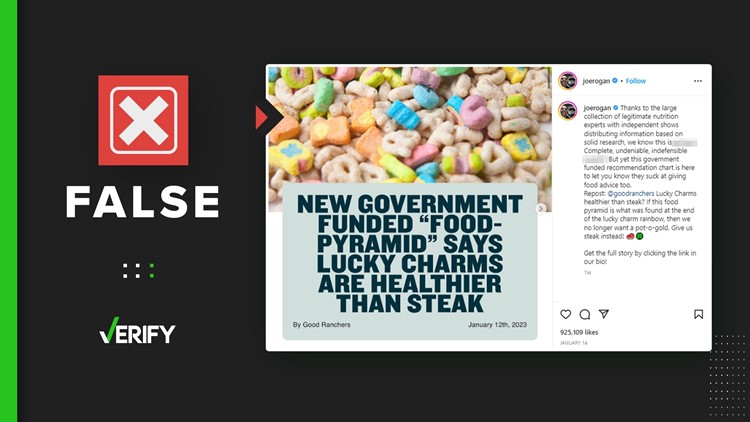Most of us know Lucky Charms are magically delicious. But did the federal government say the breakfast cereal is healthier than steak? Some people on social media claim a new federal food pyramid says that’s the case.
Podcaster Joe Rogan shared the claim in a Jan. 14 Instagram post, which has since received more than 900,000 likes. Rogan’s post shows a graph ranking certain foods, with Lucky Charms ranked higher than ground beef.
The claim, which has also been shared on Facebook and Twitter, stems from a blog post on goodranchers.com with the headline, “New government funded ‘food pyramid’ says Lucky Charms are healthier than steak.”
THE QUESTION
Does a government-funded food pyramid rank Lucky Charms as healthier than steak?
THE SOURCES
- Preprint paper titled “Limitation of the Food Compass Nutrient Profiling System”
- Ty Beal, author of the preprint paper and research advisor at the Global Alliance for Improved Nutrition (GAIN)
- Food Compass paper published by the Nature Food journal in October 2021
- Dariush Mozaffarian, professor of nutrition at Tufts University who helped develop Food Compass
- U.S. Department of Agriculture (USDA) Dietary Guidelines for 2020-2025
- U.S. Department of Health and Human Services (HHS)
- Whitney Linsenmeyer, spokesperson for the Academy of Nutrition and Dietetics and assistant professor of nutrition at St. Louis University
THE ANSWER
No, a government-funded food pyramid doesn’t rank Lucky Charms as healthier than steak.
WHAT WE FOUND
Though a graph shared online does rank Lucky Charms above ground beef, it’s not a new food pyramid.
The food pyramid, a nutritional guideline created and issued by the federal government, was a representation of food groups that make up a healthy diet. But there hasn’t been a food pyramid in the United States since 2011, Academy of Nutrition and Dietetics spokesperson Whitney Linsenmeyer said.
In 2011, the U.S. Department of Agriculture (USDA) replaced the food pyramid with MyPlate. The food guide, illustrated in the shape of a plate, focuses on eating a good portion of fruits, vegetables, proteins and dairy, and remains unchanged since 2011. It doesn’t compare steak to breakfast cereals such as Lucky Charms.
Graph origins
The graph that ranks Lucky Charms, ground beef and other food items comes from a February 2022 research paper authored by a handful of nutritionists.
That paper evaluated Food Compass, a scoring system that ranks foods on a scale of 1-100 based on their healthfulness. Food Compass was developed by researchers at Tufts University.
Ty Beal, a nutrition scientist and one of the research paper’s authors, told VERIFY the graph that’s been shared online was created using “values directly from” Food Compass to “show flaws in the system.”
The graph shows Lucky Charms with a score of 60 and labeled as “to be moderated,” while ground beef was given a score of 26 and rated as “to be minimized.” Steak itself isn’t explicitly mentioned in the chart.


Beal and the other authors critiqued Food Compass in their paper, writing in part that the system’s algorithm and "weighting of various components" is a “conceptually impressive effort,” but it is “not well justified and produces results that fail to discriminate for common shortfall nutrients, exaggerate the risks associated with animal-source foods, and underestimate the risks associated with ultra-processed food.”
“We caution against the use of Food Compass in its current form to inform consumer choices, policies, programs, industry reformulations, and investment decisions,” the authors wrote.
In response to the criticism, Dariush Mozaffarian, a nutrition professor at Tufts University who helped develop Food Compass, told VERIFY the system has scored 58,000 products and “works well.” He added that “people who eat foods with higher scores have better health: less obesity, lower blood sugar, lower blood pressure, better blood cholesterol levels, less metabolic syndrome, and lower risk of all [causes of] death.”
“One of its major strengths is negative scoring for processed foods, and for refined grains and starches. For example, breakfast cereals rich in refined grains score very low on Food Compass,” he said. “It’s unfortunate that some on social media have highlighted the few scores where Food Compass can be further improved, rather than the many scores where it works well. This exaggerates controversy, rather than highlighting all the areas of agreement.”
The Tufts researchers “have not ‘released’ Food Compass for immediate implementation,” Mozaffarian said.
“It is research in progress, and we continue to refine and update it,” he added.
Government grant funded Food Compass
Research that led to the development of Food Compass was funded in part by a grant from the National Heart, Lung and Blood Institute, which is part of the federal government’s National Institutes of Health.
But the authors of a 2021 paper on Food Compass note that its funders “had no role in study design, data collection, data analysis or interpretation, drafting of the manuscript, or decision to submit the manuscript for publication.”
Food Compass isn’t related to the federal government’s dietary recommendations, either.
USDA and the U.S. Department of Health Human Services (HHS) partner to issue Dietary Guidelines for Americans, with the most recent guidelines covering 2020-2025. A summary of those guidelines emphasizes “nutrient-dense food and beverage choices,” but doesn’t rank individual foods such as Lucky Charms and steak against one another.



